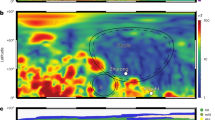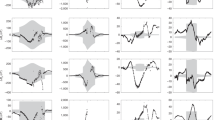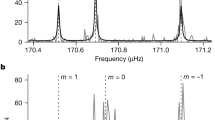Abstract
THE Galileo spacecraft has now passed close to Jupiter's largest moon—Ganymede—on two occasions, the first at an altitude of 838 km, and the second at an altitude of just 264 km. Here we report the discovery during these encounters of an internal magnetic field associated with Ganymede (the only other solid bodies in the Solar System known to have magnetic fields are Mercury, Earth and probably lo1). The data are consistent with a Ganymede-centred magnetic dipole tilted by ∼10° relative to the spin axis, and an equatorial surface-field strength of ∼750 nT. The magnetic field is strong enough to carve out a magnetosphere with clearly defined boundaries within Jupiter's magnetosphere. Although the observations require an internal field, they do not indicate its source. But the existence of an internal magnetic field should in itself help constrain models of Ganymede's interior.
This is a preview of subscription content, access via your institution
Access options
Subscribe to this journal
Receive 51 print issues and online access
$199.00 per year
only $3.90 per issue
Buy this article
- Purchase on Springer Link
- Instant access to full article PDF
Prices may be subject to local taxes which are calculated during checkout
Similar content being viewed by others
References
Kivelson, M. G. et al. Science 273, 337–340 (1996).
Kivelson, M. G., Khurana, K. K., Means, J. D., Russell, C. T. & Snare, R. C. Space Sci. Rev. 60, 357–383 (1992).
Khurana, K. K. J. Geophys. Res. (submitted).
Connerney, J. E. P. in Planetary Radio Emissions III (eds Rucker, H. O., Bauer, S. J. & Kaiser, M. L.) 13–33 (Osterreichischen Akademie der Wissenschaftern, Vienna, 1992).
Neubauer, F. M. J. Geophys. Res. 85, 1171–1178 (1980).
Southwood, D. J., Kivelson, M. G., Walker, R. J. & Slavin, J. A. J. Geophys. Res. 85, 5959–5968 (1980).
Gurnett, D. A., Kurth, W. S., Roux, A., Bolton, S. J. & Kennel, C. F. Nature 384, 535–537 (1996).
Hughes, W. in Introduction to Space Physics (eds Kivelson, M. G. & Russell, C. T.) 227–287 (Cambridge Univ. Press, New York, 1995).
Kivelson, M. G., Khurana, K. K., Walker, R. J., Warnecke, J. & Russell, C. T. Science 274, 396–398 (1996).
Blackett, P. M. S. Nature 159, 658 (1947).
Anderson, J. D., Shogren, W. L. & Schubert, G. Science 272, 709–711 (1996).
Schubert, G., Zhang, K., Kivelson, M. G. & Anderson, J. D. Nature 384, 544–545 (1996).
Elphic, R. C. & Russell, C. T. Geophys. Res. Lett. 5, 211–214 (1978).
Dressler, A. J. in Physics of the Jovian Magnetosphere (ed. Dressler, A. J.) 498–504 (Cambridge Univ. Press, New York, 1983).
Author information
Authors and Affiliations
Rights and permissions
About this article
Cite this article
Kivelson, M., Khurana, K., Russell, C. et al. Discovery of Ganymede's magnetic field by the Galileo spacecraft. Nature 384, 537–541 (1996). https://doi.org/10.1038/384537a0
Received:
Accepted:
Issue Date:
DOI: https://doi.org/10.1038/384537a0
This article is cited by
-
Interiors of Earth-Like Planets and Satellites of the Solar System
Surveys in Geophysics (2022)
-
Estimation of the Ephemerides and Gravity Fields of the Galilean Moons Through Orbit Determination of the JUICE Mission
Aerotecnica Missili & Spazio (2021)
-
Heat and charge transport in H2O at ice-giant conditions from ab initio molecular dynamics simulations
Nature Communications (2020)
-
Strong whistler mode waves observed in the vicinity of Jupiter’s moons
Nature Communications (2018)
-
Water and the Interior Structure of Terrestrial Planets and Icy Bodies
Space Science Reviews (2018)
Comments
By submitting a comment you agree to abide by our Terms and Community Guidelines. If you find something abusive or that does not comply with our terms or guidelines please flag it as inappropriate.



